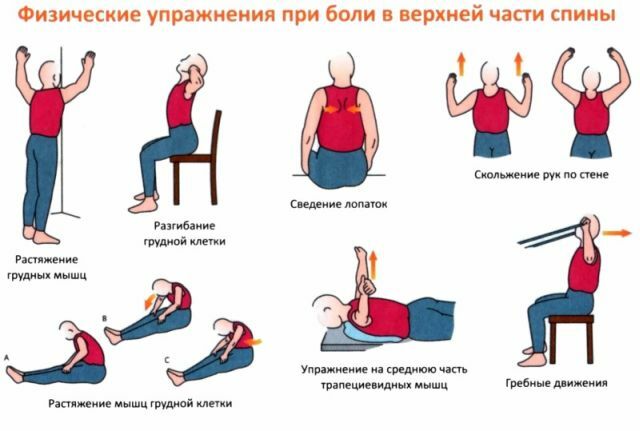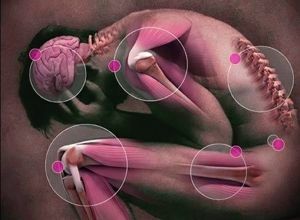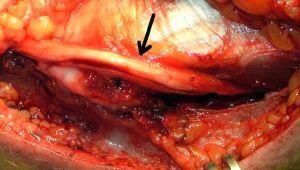 Do you often experience sudden, severe pain in your leg? This phenomenon is the main symptom of the disorder, at which the nerve is trapped.
Do you often experience sudden, severe pain in your leg? This phenomenon is the main symptom of the disorder, at which the nerve is trapped.
This pathology itself does not arise and does not go away and is often accompanied by rather severe pains, which cause permanent discomfort.
Pinching occurs when the roots of the nerves that leave the spinal cord are compressed by vertebrae or other possible formations, both pathological and completely anatomical, such as spasms, cartilages, tumors, tendons, hernias, and others.
Pincushion is always accompanied by a strong pain syndrome, which patients describe as burning, shooting, stitching or drawing pains depending on the localization of the problem.
Contents of the article
- View the root or where the cause lies
- Comprehensive picture of the violation
- Provide quick first aid
- Diagnostic procedures
- Comprehensive medical care
- Applied methods
- Summing up
See at the root or where the cause lies
The main and most common cause is the intervertebral hernia. She, in turn, is often a companion of such  disease as osteochondrosis. In this disease, the anatomical structure of the intervertebral discs is disturbed, with some of the disc may extend beyond the spinal column and squeeze nerves.
disease as osteochondrosis. In this disease, the anatomical structure of the intervertebral discs is disturbed, with some of the disc may extend beyond the spinal column and squeeze nerves.
The sciatic nerve, the pinching of which most often causes pain in the leg, is formed from the roots of the spinal nerves located in the lumbosacral spine. He reacts with pain to the infringement of these roots and gives the whole leg.
The following factors are considered the reasons why the nerve on the foot is pinched:
- osteochondrosis in the acute stage of the disease;
- radiculitis;
- benign and malignant tumors;
- strong physical activity and trauma.
The sciatic nerve is the longest and thickest in the body. It is formed by the five rootlets of the spinal nerves with two lower lumbar and three upper sacral nerves. Descending along the surface of the buttocks and hips, it branches to the muscles that are located there. In popliteal fossa divided into two nerves.
Pinch of the sciatic nerve occurs in the region of the spinal roots. Pain in this case is called ishalgia, if 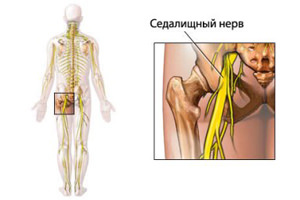 is added with shooting symptoms - lumboeishalgia.
is added with shooting symptoms - lumboeishalgia.
Strangely enough, very often there is a pinched nerve in pregnancy. When the uterus increases in size as the pregnancy progresses, it begins to squeeze the neighboring organs, which leads to the development of the same pathology.
During pregnancy it is considered a variant of the norm, however it can cause severe discomfort. The appointment of any medication should be agreed with the obstetrician-gynecologist taking into account the "interesting" situation.
Complex pattern of disturbance of
The main symptoms that indicate that the nerve is pinched in the lower part of the body or in the legs are:
- acute sharp pains in the area of entrapment;

- tingling and pain giving in the leg;
- skin changes to red, swelling;
- is rare, but still there is such a symptom as increased sweating;
- is often impossible to unbend the knees in the morning, as the disease progresses, the symptom becomes permanent;
- intolerable pain when in an upright position;
- pain in the lumbar region.
It is for the pinch of the sciatic nerve that such symptoms and signs are characteristic:
- Pain in the legs .It can range from mild discomfort to quite strong.
- Back pain .Usually weaker than the pain in the legs, but often causes severe discomfort when walking.
- Sensitivity change .There may be numbness, tingling and tingling, while spreading all over the leg from the hip to the foot.
- Decreased motor activity and gait violation .
- Reduction of muscle strength .
Providing quick first aid
What to do if you have strongly caught the lower back with an irradiation of pain in your lower limbs and there is a suspicion that the nerve in your leg is pinched, and it's impossible to see a doctor right away?
The following measures will help to remove the pain:
- taking an anesthetic drug, it can be either an analgesic or a drug from the group of non-steroidal
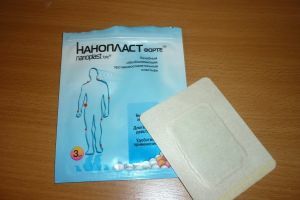 anti-inflammatory drugs;
anti-inflammatory drugs; - lie on a flat solid surface, restrict movement, you can put a pillow under your knees to keep your legs in a raised state;
- you can apply an anti-inflammatory compress or use a patch for back pain;
- as an option to spread the lower back with ointment containing anti-inflammatory drugs, analgesics or pain medications;
- at the first opportunity to seek qualified help in a medical institution.
Diagnostic procedures
Before the beginning of the course of treatment the patient should undergo a diagnosis. Often doctors prescribe x-rays of the spine and leg bones, and sometimes, computer and magnetic resonance imaging. This is done for the purpose of finding out the reason that triggered the jam.
The exception is the state of pregnancy, when diagnosis is not required and is not recommended. In such cases, most pathology will pass by itself after childbirth.
If a tumor is suspected, scintigraphy and radiological examination of the spine are performed.
Comprehensive medical care
Treatment, in cases where nerve injury in the leg is diagnosed, consists of several steps:
- First, the nerve fiber needs to be freed from the clamped state of the , which is what causes the pain. For this, a variety of techniques are used, such as massage, manual therapy, physiotherapy and others. In most cases, remove the jam is obtained quite quickly. Especially if it is not accompanied by a tumor or protrusion.
- Second recovery of nerve function .To do this, complex therapy is prescribed, which includes both medicines and various vitamin complexes.
- Thirdly, what is done is mandatory, this finds out the reason why the nerve of is clamped. After it becomes clear what the reason for this pathology is treated with consequences.
Applied methods
 Treatment should be comprehensive and consist, as already mentioned, not only in the use of drug therapy, but also in physical effects: manual therapy, physiotherapy, physiotherapy exercises.
Treatment should be comprehensive and consist, as already mentioned, not only in the use of drug therapy, but also in physical effects: manual therapy, physiotherapy, physiotherapy exercises.
First of all, if symptoms are found, heat should be applied. For this, a mustard, a warm compress or warming ointments can be used.
It is necessary to use anti-inflammatory drugs such as Diclofenac, Ibuprofen, Indomethacin, and novocain blockades are also used. For local use, the same remedies are used in the form of ointments or patches.
After removal of acute pain syndrome, physiotherapy procedures are prescribed. It is good for these purposes to use Darsonval, amplipulse, UHF 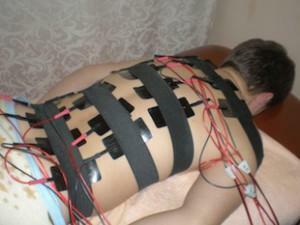 and others. Then can be applied manual therapy, acupuncture, acupressure.
and others. Then can be applied manual therapy, acupuncture, acupressure.
Patients should adhere to the general recommendations, among which the change of diet, - exclude pickled, smoked, spicy, salty and alcoholic drinks.
A popular and rather effective method is massage.
Massage in addition, it can improve the condition with osteochondrosis.
But it is done only outside the acute phase of the disease, and in any case, it must be done by a competent specialist with a higher medical education.
Special exercises are also prescribed, among them: lifting the body in the supine position, back down, stretching exercises and relaxation.
Summing up
If the disease can not be cured in time, it can lead to such complications:
- the death of nerve endings;
- of leg paralysis;
- marked weakness in the extremities;
- atrophy of pelvic organs;
- instability of the spine.
To prevent the disease, it is recommended to do daily exercises, you can do exercises: a cat, a bicycle, and slow squats. Good help is any exercise that helps strengthen the muscles of the back. You can periodically massage.
It is very important to constantly monitor your posture and keep your back straight. It is less to try to walk on his heels.
For a long time in one position, take breaks. During pregnancy wear a special supporting bandage.

